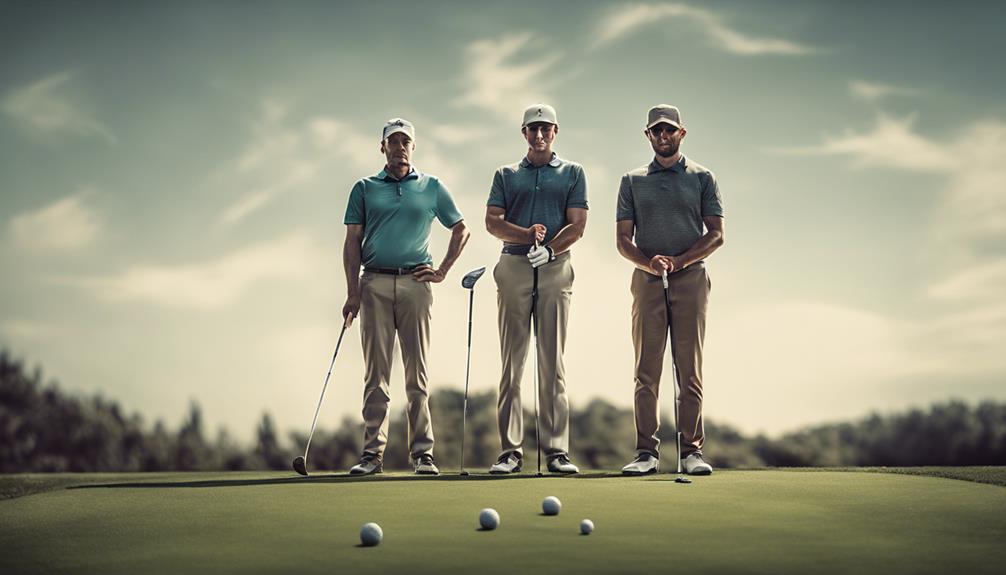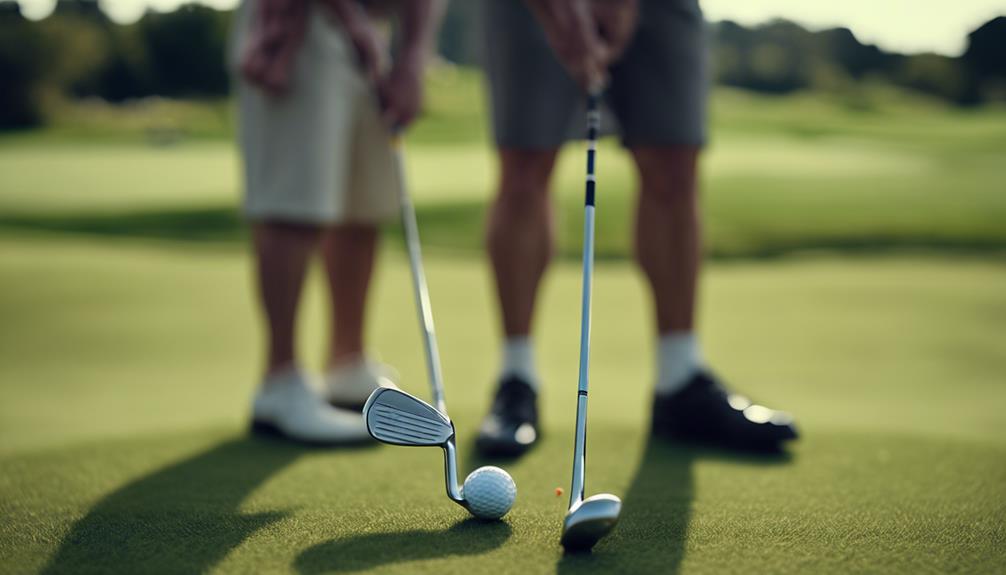- 7 Top Flite Golf Clubs XL for Improved Performance - September 28, 2024
- Top Flite Golf Clubs: Top 5 Reasons to Choose Them - September 28, 2024
- Top 3 Golf Club Fitters for a Perfect Swing - September 28, 2024
You don't need to settle for a one-size-fits-all approach to golf clubs. The perfect fit depends on a combination of factors, including your height, swing style, posture, and skill level. Height is a critical factor, but it's not the only consideration. Your swing style, whether it's neutral, sweep, or steep, also plays a significant role in determining the right club length and lie angle. By understanding your unique factors, you can find the ideal club length that suits your game. And, by digging deeper into the specifics, you'll discover how to tap into your full golfing potential.
Key Takeaways
- Golf club size depends on various factors, including height, swing style, posture, and skill level, making one-size-fits-all impractical.
- Height is the most critical factor in determining ideal golf club length, with taller golfers requiring longer clubs and shorter golfers needing shorter ones.
- Swing style, including neutral, sweep, and steep, directly influences club length, lie, and loft, affecting ball flight, control, and overall performance.
- Wrist-to-floor measurement, rather than height, provides a more accurate method for determining club size, as it considers individual factors like swing style and posture.
- Custom fit golf clubs, tailored to unique swing style, posture, and physical characteristics, are essential for optimal performance and enjoyment of the game.
Debunking the One-Size Myth
When you step into a golf store, you're often led to believe that one-size golf clubs fit all, but the reality is that this myth couldn't be further from the truth.
The fact is, golf club size depends on various factors, including your height, swing style, posture, and skill level.
As a golfer, your height is the most critical factor in determining the ideal golf club length. Taller golfers require longer clubs, while shorter golfers need shorter ones.
The lie angle of the club also plays a significant role in determining the club's length. Manufacturers may adjust the lie angle instead of making the club longer to accommodate taller individuals or those with high wrist-to-floor measurements.
Using a combination of your height and wrist-to-floor measurement can provide a more accurate determination of club length.
Don't fall for the one-size myth; instead, consider getting custom-fit golf clubs or demo clubs of various lengths to find the perfect fit for your game.
Understanding Your Swing Style
As you refine your game, understanding your swing style becomes a critical component in determining the correct golf club size, as it directly influences the club's length, lie, and loft, ultimately affecting ball flight, control, and overall performance.
To get it right, you need to identify your swing style, which falls into one of three categories: neutral, sweep, or steep.
- Neutral: Smooth, balanced swing with a moderate attack angle and club face closure.
- Sweep: More horizontal swing path with a shallow attack angle and slower club face closure.
- Steep: More vertical swing path with a steeper attack angle and faster club face closure.
- Shaft flex: Matches your swing speed and tempo to optimize club performance.
Accurate club fitting for your swing style can lead to significant improvements in accuracy, distance, and overall enjoyment of the game.
Club Size and Height Matters

You'll dramatically improve your game by recognizing that correct golf club size is vital, and inaccurate club length can have the opposite effect, making the game more challenging and less enjoyable.
When it comes to determining the right club size, your height is a key factor. Generally, taller golfers require longer clubs, while shorter golfers need shorter ones.
However, relying solely on height can be misleading. That's where wrist-to-floor measurements come in – a more accurate method for determining club size. By measuring from your wrist to the floor, you'll get a better sense of the correct club length for your body.
While a standard length chart can serve as a rough guide, you must take into account individual factors like swing style and posture to guarantee the perfect fit. Remember, golf club fitting isn't a one-size-fits-all approach.
Lie Angle and Its Importance
As you explore the importance of lie angle, you'll discover how it impacts your game in key ways.
The angle at which your clubhead aligns with the ground affects not only the ball's flight but also your overall swing consistency.
Clubhead Alignment Matters
When fitting golf clubs, you must pay attention to the lie angle, as this aspect has a profound impact on the club's overall performance, particularly with regard to clubhead alignment.
The lie angle affects the club's length, with a 1° increase raising the butt end of the grip approximately 1/3' off the ground. This can be crucial for taller individuals or those with high wrist-to-floor measurements, as manufacturers may opt to adjust the lie angle instead of lengthening the club.
Lie angle affects club length: A 1° increase in lie angle raises the butt end of the grip approximately 1/3' off the ground.
Manufacturers adjust lie angle: Instead of lengthening the club, manufacturers may change the lie angle to accommodate taller individuals or those with high wrist-to-floor measurements.
Swingweight is critical: Different combinations of length and lie can produce the same swingweight, making it a critical factor in determining the correct club length and lie for a golfer.
Proper lie angle ensures square clubface: A proper lie angle ensures the clubface is square to the target line at impact, which is essential for accurate shots.
Angle Affects Ball Flight
By understanding how the lie angle affects ball flight, golfers can optimize their club selection and swing technique to achieve more consistent and accurate shots.
The lie angle, measured in degrees, profoundly impacts the club's performance. A 1° increase in the lie angle raises the butt end approximately 1/3' off the ground, while the center of the sole remains in contact with the ground.
This alteration affects the club's length, and manufacturers often adjust the lie angle instead of increasing the club's length to accommodate taller golfers or those with higher WTF measurements. For instance, a standard 5-iron has a lie angle of around 61° and a length of 37.25' to achieve the B length.
The swingweight of the club also plays a vital role, as different length and lie combinations can produce the same sole-to-ground contact. A 1° change in lie angle can result in a 0.5' to 1' difference in the effective length of the club, markedly impacting ball flight.
Fitting for Consistency
To guarantee consistent ball-striking and peak performance, you need to fit your golf clubs to your unique swing characteristics, and that starts with getting the lie angle just right. A lie angle that's too upright or too flat can cause the club to hit the ground too close to the heel or toe, resulting in inconsistent shots and poor accuracy.
The key factors in fitting for lie angle are:
Unique swing characteristics: Golfers with more upright or shallow swing planes may require a customized lie angle to achieve ideal results.
Lie angle adjustments: For every 1-degree change in lie angle, the clubhead can shift up to 0.5 inches, markedly affecting the club's performance.
Correct shaft selection: A club fitter will help you select the correct shaft to match your lie angle, ensuring consistent ball-striking and improved accuracy.
Fitting process: A thorough fitting process will help you identify the perfect lie angle for your swing, resulting in better overall performance on the course.
Measuring for the Perfect Fit

Measuring yourself accurately is essential in determining the perfect fit for your golf clubs, as even slight variations in height and wrist-to-floor measurements can substantially impact your swing.
To get it right, you'll need to take into account both factors. Height is key, with a general rule of thumb being to add or subtract 1 inch from the standard length for every 6 inches of height difference.
Your wrist-to-floor measurement is also vital, with the average being 48.9% of your height. By cross-referencing these two measurements, you'll get a more accurate result, as arm lengths don't always proportionally match height.
A static fitting involves measuring from your fingertip or wrist to the floor and determining your grip size to find the correct club length.
Remember, the right length is critical, and it's not just about height and wrist-to-floor measurement – lie angle and swingweight also play a role.
Custom Fit Golf Clubs Explained
You're about to discover how custom fit golf clubs can revolutionize your game by catering to your unique swing style, posture, and physical characteristics.
By getting fitted for clubs that match your individual needs, you can improve your overall performance and enjoyment of the sport.
Accurate measurements: A professional club fitter will take precise measurements of your height, wrist-to-floor distance, and grip size to determine the perfect fit.
Dynamic fitting: Using a launch monitor, your fitter will analyze your swing to determine the ideal shaft and head for your Driver, Iron Set, and other clubs.
Cross-referencing: By combining your height and wrist-to-floor measurements, your fitter can account for variations in arm length and other physical characteristics to guarantee a precise fit.
Optimal club selection: Your fitter will help you choose the right clubs, including Regular Flex shafts, to match your swing style and preferences.
Fitting Golf Clubs for Your Game

By recognizing the importance of custom fit golf clubs, you can now focus on fitting golf clubs specifically tailored to your game, taking into account your unique physical characteristics, swing style, and playing preferences.
This requires considering factors like height, posture, and skill level to make the right selection of golf clubs. A golf club sizing chart or wrist-to-floor measurement can help determine the perfect club length, ensuring you're playing with the right golf clubs for your game.
Custom fit golf clubs can be achieved through static or dynamic fitting, which involves measuring your grip size and determining the correct shaft and head. With different shaft lengths and club heads available, it's essential to find the right combination that suits your swing style.
A professional golf club fitting service can help you create a set of clubs that's tailored to your unique needs, leading to more accurate iron play and better distance control. By investing time in fitting golf clubs for your game, you'll be able to make the most of your skills and enjoy the game to its fullest.
Finding the Right Club Length
When selecting golf clubs, determining the correct club length is essential, as it substantially impacts your overall performance and comfort during play. Your height is the most critical factor in determining the right club length, and a quick golf club size guide can help you make the right selection.
To find the perfect club length, you can use a golf club sizing chart or measure the distance from your wrist to the floor.
Additionally, take into account the following key factors:
- Height: Your height is the primary determinant of club length, so make sure to get it right.
- Lie angle: The lie angle affects the length of the club, so it's vital that you factor it in when selecting your clubs.
- Wrist-to-floor measurement: This measurement provides an accurate method for determining club size.
- Custom fitting: Think about getting custom-fit golf clubs through static or dynamic fitting to guarantee the perfect club length for your game.
Frequently Asked Questions
How to Measure Golf Clubs to Fit You?
When measuring golf clubs to fit you, consider your club length based on height, hand style, and wrist angle, factoring in your body type, to guarantee a precise fit that optimizes your swing and performance.
How Do You Size Golf Clubs for Your Height?
As you stand tall, coincidentally, your height isn't the only factor in sizing golf clubs; you'll also need to take into account your golf posture, body type, swing style, and flexibility level to find the perfect fit.
Are Mens Golf Clubs All the Same Size?
You'll find that men's golf clubs aren't all the same size due to club length variation, differences in shaft material, grip size options, and head weight disparity, which all impact your swing and overall performance.
Are All Womens Golf Clubs the Same Size?
When selecting women's golf clubs, you'll find varying sizes based on individual preferences, club selection, and gender differences, considering factors like hand dominance, swing style, and wrist-to-floor measurements to guarantee the perfect fit.
Conclusion
As you stand on the tee, your clubs should be an extension of yourself, a harmonious union of precision and power.
But a one-size-fits-all approach is like trying to force a square peg into a round hole – it just won't work.
By understanding your swing style, club size, and lie angle, you can tap into your full potential and drive your game forward with precision and confidence.
The perfect fit is out there, and with the right measurements, you'll be swinging like a pro in no time.




